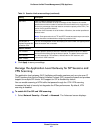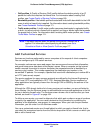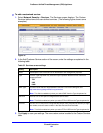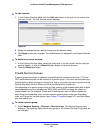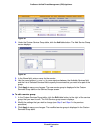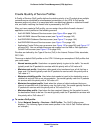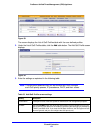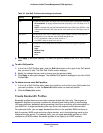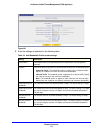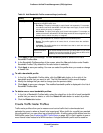
Firewall Protection
169
ProSecure Unified Threat Management (UTM) Appliance
Create Quality of Service Profiles
A Quality of Service (QoS) profile defines the relative priority of an IP packet when multiple
connections are scheduled for simultaneous transmission on the UTM. A QoS profile
becomes active only when it is associated with a nonblocking inbound or outbound firewall
rule, and traffic matching the firewall rule is processed by the UTM.
After you have created a QoS profile, you can assign the profile to firewall rules and
application control profiles on the following screens:
• Add LAN WAN Outbound Services screen (see Figure 68 on page 141).
• Add LAN WAN Inbound Services screen (see Figure 69 on page 142).
• Add DMZ WAN Outbound Services screen (see Figure 71 on page 144).
• Add DMZ WAN Inbound Services screen (see Figure 72 on page 145).
• Application Control Policy pop-up screens (see Figure 136 on page 245 and Figure 137
on page 245). You can access these pop-up screens from the Add or Edit Application
Control Profile screen (see Figure 135 on page 243).
Priorities are defined by the Type of Service (ToS) in the Internet Protocol Suite standards,
RFC 1349.
There are no default QoS profiles on the UTM. Following are examples of QoS profiles that
you could create:
• Normal service profile. Used when no special priority is given to the traffic. You would
typically mark the IP packets for services with this priority with a ToS value of 0.
• Minimize-cost profile. Used when data needs to be transferred over a link that has a
lower cost. You would typically mark the IP packets for services with this priority with a
ToS value of 1.
• Maximize-reliability profile. Used when data needs to travel to the destination over a
reliable link and with little or no retransmission. You would typically mark the IP packets
for services with this priority with a ToS value of 2.
• Maximize-throughput profile. Used when the volume of data transferred during an
interval is important even if the latency over the link is high. You would typically mark the
IP packets for services with this priority with a ToS value of 3 or 4.
• Minimize-delay profile. Used when the time required (latency) for the packet to reach
the destination needs to be low. You would typically mark the IP packets for services with
this priority with a ToS value of 7.
To create a QoS profile:
1. Select Network Security > Services > QoS Profiles. The QoS Profiles screen
displays. (The following figure shows some profiles in the List of QoS Profiles table as
an example.)



